Assistive Technology User Guides
Voice Control

On this page:
Dragon
Dragon is software that allows for dictating text and operating a computer using voice commands.
Setup
Use an external microphone to cut down on background noise and ensure maximum accuracy in dictation and voice commands. Make sure microphone is plugged in before starting Dragon. To ensure Dragon is using the correct microphone source:
- Open Profile menu.
- Choose Manage Dictation Sources…
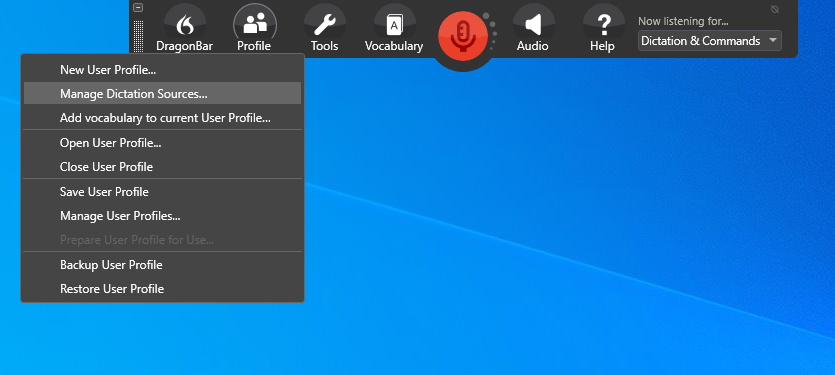
- Choose correct source.
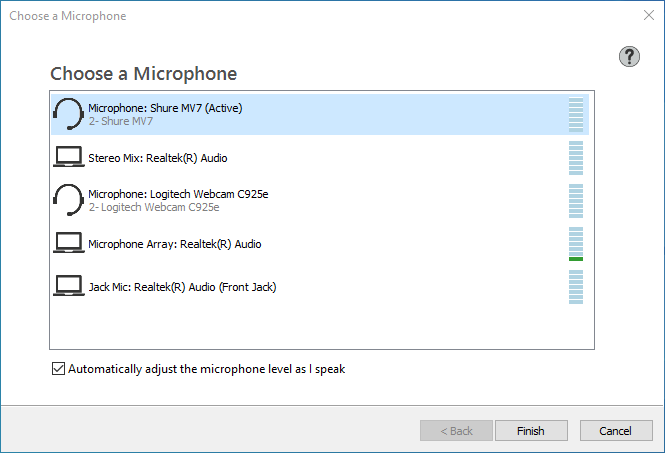
- Click Finish.
If using Dragon on the web (Brightspace, O365, Google Docs, etc.) install Dragon extension for Chrome.
When first using Dragon, set up a user profile. Dragon will walk users through setting up a profile, adjusting the microphone, and tuning the software to their voice. After creating a profile, Dragon will automatically open an interactive tutorial. This tutorial is recommended for new users and introduces basic Dragon features, dictation, correction, and editing.
Basic Functions
To turn Dragon on or off:
- When the speaker icon is red, Dragon is not listening. Click the icon to start Dragon.

- When the speaker icon is green, Dragon is listening and will transcribe what is said.

- Click the green icon to stop Dragon.
- When dictating, say “go to sleep” and the icon will turn blue. Dragon is in sleep mode and won’t transcribe what is said. Say “wake up” or click the icon to continue using Dragon to transcribing speech.

- On a desktop computer, press the + key beside the number pad to toggle the microphone on and off.
In addition to using the Help menu, users can say “Dragon learning center” or “What can I say?”
Dictation
To dictate text using dragon open a word processor, DragonPad, or Dictation Box.
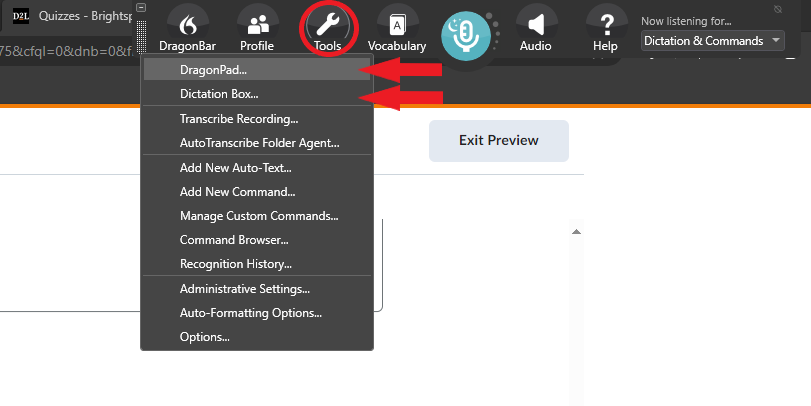
- Ensure the blinking text cursor is in the area you want to dictate text.
- Activate Dragon.
- Begin speaking.
- Text will be transcribed directly into the text field selected.
DragonPad
Open DragonPad by saying “Open DragonPad” or by selecting Tools > DragonPad…
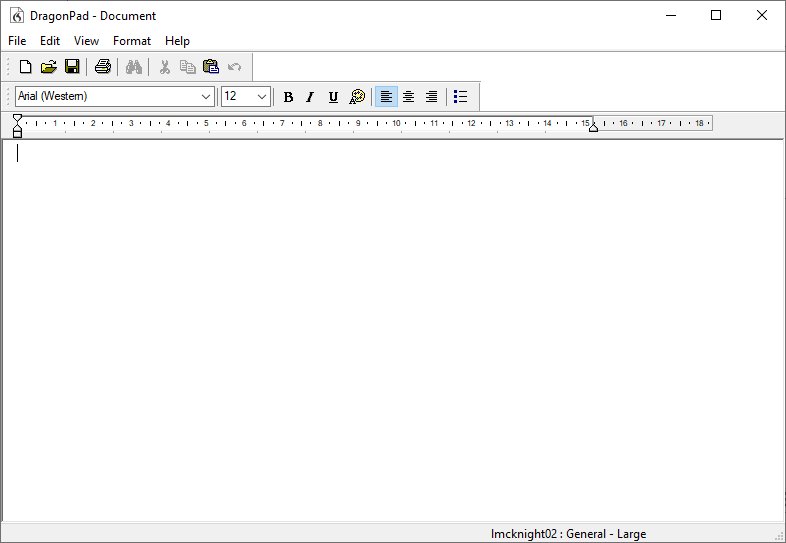
DragonPad can be used as a basic word processor. Users can save in common formats from DragonPad or copy and paste into other programs.
Dictation Box
Open Dictation Box by saying “Open Dictation Box” or by pressing Control Shift d or by selecting Tools > Dictation Box…
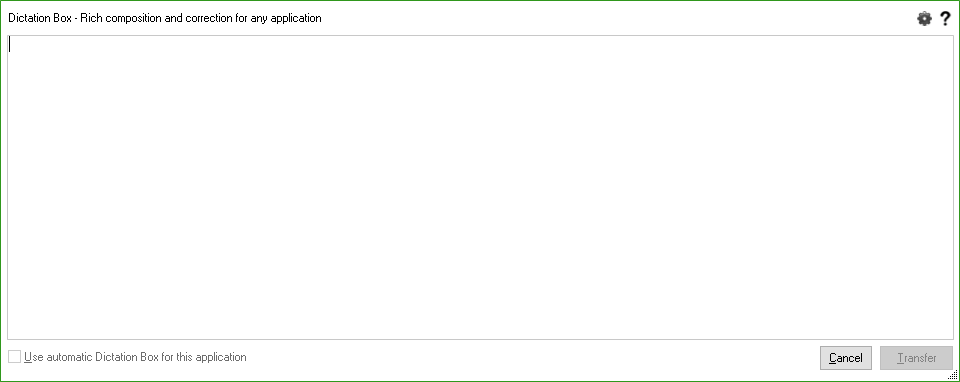
To use Dictation Box the mouse cursor must be in the field where text is to be entered.
When using Dictation Box, select and copy (using right-click > Copy or Control c) all dictated content then paste (right-click > Paste or Control v) in appropriate field to avoid possibility of losing dictated text with Transfer tool. Very rarely the built-in Transfer button will not work and dictated content could be lost.
Speak naturally as Dragon transcribes more accurately when there are as few pauses as possible.
To add punctuation, say:
- “Period” or “full stop”
- “Comma,” “exclamation mark,” or “question mark.”
- “open paren,” “close paren,” “open quote,” “close quote”
- “at sign,” “plus sign,” “underscore,” “semi colon,” etc.
- After transcribing text, say “bullet that,” “bold that,” or “underline that.”
- Say “new line” and “new paragraph” to move to a new line.
To delete transcribed text, say:
- “delete that” or “undo that” to delete last transcribed text.
- “delete last (number) words” to delete the last (number) of words.
- “delete last line”
If Dragon makes a spelling error, say “correct that.” If the correct word appears in the menu, select it to automatically replace the incorrect word with the correct one. If the correct word does not appear in the menu, say “spell that” and spell the word letter by letter.
Vocabulary Editor
Vocabulary Editor allows users to search for terms and refine Dragon’s speech recognition. Select Vocabulary on DragonBar to access vocabulary tools such as Learn from, Add new word or phrase, and Vocabulary editor. Users can personalize Dragon’s dictation by navigating to Help > Improve my accuracy.
Voice Commands
Commons commands for controlling a device:
- “Open (application)” “Start (application)”
- “Switch to (open application)
- “Show desktop”
- “Click Start”
- “Close window”
- “Cancel” “Press Escape”
- In browser “search Google for…”
- Select text:
- “Select all” “Unselect that”
- “Select (speak words to be selected)”
- “Select next (number) words”
- “Select previous paragraph”
- Note: Caret browsing must be enabled to select text on the web. Press F7 to turn on Caret browsing.
- “Copy that” “Cut that” “Paste that”
Navigating the Internet
To use Dragon to navigate the internet:
Install Dragon extension for Chrome.
Useful voice commands include:
- “Go to address bar”
- “Click (link name)”
- “Go to next tab” “Go to third tab” etc.
- “Click type text” to see all the places where text can be entered.
If having difficulty navigating on the web, try saying “Show links” or “Show choices” and then say “Choose (number)” of the link or field you would like to select. This is helpful for most interactive elements such as text fields, radio buttons, and checkboxes as well.
Mousegrid
MouseGrid allows Dragon users to move the mouse with speech recognition.
- Say “MouseGrid”
- Say “click (1 to 9)” to select grid
- Repeat until cursor is on item to be clicked.
- Say “click that”
Options and Tools
Migrating User Profile
- Plug in USB drive
- Launch Dragon
- Select Profile button > Manage User Profiles
- Choose profile
- Click Advanced
- Select Export
- Choose location (USB drive)
- Eject USB and move to new computer
- Launch Dragon
- Select Profile button > Manage User Profiles
- Click Advanced
- Select Import
- Choose folder copied from other computer
Recognition History
Dragon retains a history of “recognized utterances” or a list of the recent things users have said that Dragon has recognized. This tool may be useful if user loses work dictated but not saved. However, in the Recognition History window the users speech may be broken up into many different lines and may cause frustration. Remind users to save often.
To open Recognition History:
- On the Dragon toolbar, select Tools
- Select Recognition History…
- Click Save… to save the entire recent history as a plain text file. That file can then be used to recover lost text.
- Or, users can select individual utterances and copy the text from the Utterance Selection window.
Speed vs. Accuracy
Open Tools > Options > Miscellaneous change the Speed vs. Accuracy slider. This setting increases or decreases the number of words Dragon searches in its vocabulary as it processes speech. More words examined, the greater the accuracy. However, more examination requires greater computing power.
Use Dictation Box for Unsupported Applications
Disable Dragon Dictation Box in unsupported programs (such as LockDown browser)
- Navigate to DragonBar, Tools > Options
- Select Miscellaneous tab
- Uncheck Use the Dictation Box for unsupported applications checkbox
- Click Ok.
Transcription
Dragon can be used to transcribe .wav, .mp3, .wma, .dss, .ds2, and .m4a audio files to text.
- Open Tools menu
- Select Transcribe Recording
- Choose file
- Click Transcribe
Dragon creates a .rtf text file that can be opened in and edited in DragonPad or Word directly or saved for later.
Mention, link to other chapter.
Links and Further Reading
Visit Dragon Watch and Learn for videos of common Dragon features in action.
macOS/iOS Voice Control
Voice Control allows users to navigate and interact with macOS using only their voice. To enable:
- Navigate to System Settings
- Select Accessibility
- Choose Voice Control
- Toggle Voice Control on
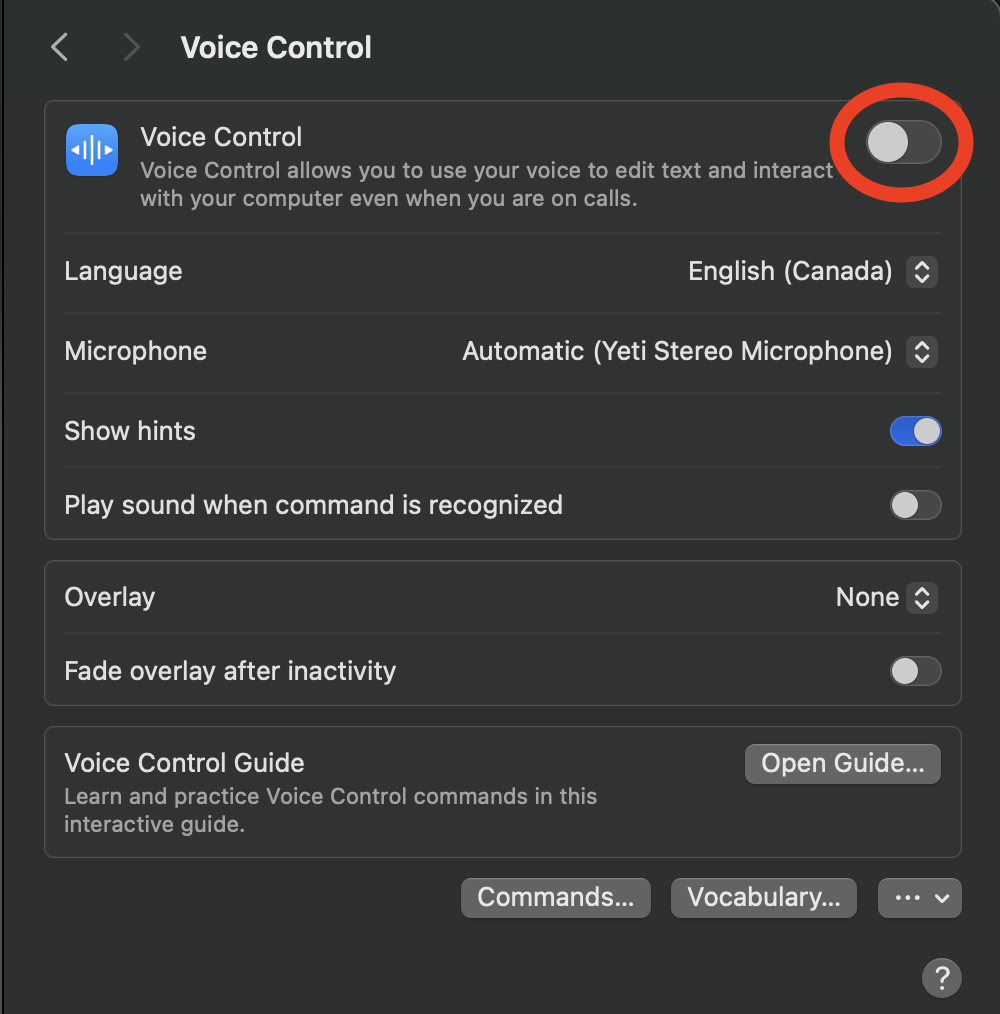
Select Commands… and Vocabulary… for further information on available functions and improving the computer’s understanding of the user’s pronunciation.
Click Open Guide… to learn how to use Voice Control.
Voice Control is also available on iOS for iPhones.
- Navigate to Settings > Accessibility.
- Choose Voice Control.
- Tap Set Up Voice Control.
- Select Open Voice Control Guide for help.
- The Voice Control menu has many options to customize user experience.
Say “go to sleep” to pause listening, “wake up” to resume. Say “show names”,” show grid” or “show numbers”
Use Voice Control to interact with iPhone
Tips:
Use natural language, such as “open Mail” or “quit System Settings”.
For more advanced functions, try saying “show numbers”. This will display numbers next to available choices, say “click [number]” to select the desired function.
Say “show grid” to enable a virtual cursor that allows you to interact with items displayed on screen without a control. With the grid displayed, say whichever number the desired item is in, repeat as needed to refine selection. Then say “click [number]” to select desired element. Say “hide grid” to turn off grid.
Learn more about using Voice Control on your Mac.
Android
Android has a tool called Voice Access to control devices using voice.
Voice Access
- Navigate to Settings > Accessibility.
- Choose Interaction and dexterity.
- Select Voice Access.
- If not installed, you will be taken to the Google Play Store.
- Navigate to Settings > Accessibility.
- Choose Installed apps.
- Select Voice Access.
- Toggle Voice Access shortcut to On.
- Toggle Voice Access to on, or use the Accessibility shortcut to select Voice Access.
- A blue icon with a sound wave will appear on your screen when Voice Access is available.

